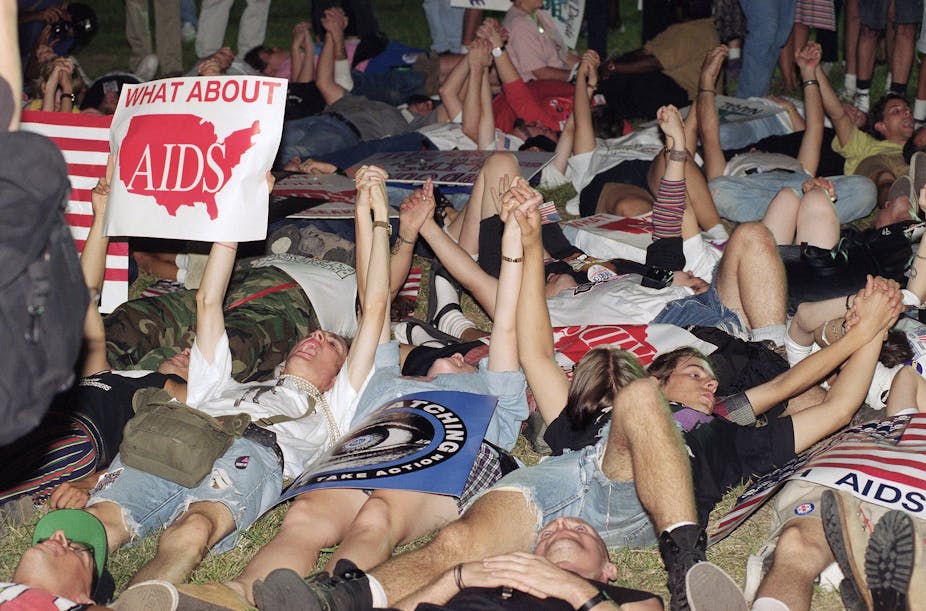A recent study by the Antiretroviral Therapy Cohort Collaboration found that young people living with HIV have about the same life expectancy as the general population. This encouraging news joins other recent findings highlighting just how far the battle against HIV/AIDS has come. Much of this progress is due to the substantial investments U.S. taxpayers have made in research and public health over the past 36 years to stop the disease’s spread.
But as a scientist and registered nurse who deals with the effects of budget cuts every day, I see reasons for concern.
Public investment, moral imperative
The U.S. public investment in the HIV epidemic started in the 1980s as a moral imperative, as many people living with HIV were quickly dying from AIDS during the first two decades of the epidemic. By the end of the 20th century, the virus had no boundaries – it spread from country to country, no visa required.
The virus was infecting men, women, children and newborns from all backgrounds and countries, often striking down those who were in the most productive years of their lives. Mothers could no longer care for children, children were rendered orphans, and young adults were unable to work and provide for their families.

In 1996, highly effective HIV medications emerged, dramatically decreasing deaths from AIDS and allowing people with HIV to live higher-quality, more productive lives. For the 18 million people with access to HIV medications, HIV has become a chronic disease akin to heart disease or diabetes. This remarkable achievement has been possible only because of U.S. tax policy and our eventual recognition that we needed to harness our resources to help people affected by this virus.
On June 5, it will be 36 years since HIV was first reported, and the return on investment in this epidemic has been high. HIV is now a chronic, rather than fatal, disease throughout the world. New infections are dropping, and we are closer than we have ever been to achieving our goal of the “end of AIDS.”
The U.S. federal government spent nearly US$33 billion on funding for HIV/AIDS care, prevention and research last year – $26.4 billion domestically and $6.6 billion globally. That amount is likely to fall as President Donald Trump’s 2017 budget called for cutting about $340 million from domestic and international HIV funding, and his team may wipe out up to $6 billion in global spending on treating and preventing the disease.
Shared benefits
It’s not just individuals infected with HIV and their families who benefit from this investment. The scaling up of HIV medication to people with HIV and others at risk for HIV (an innovative strategy known as pre-exposure prophylaxis, or “PrEP”) has helped to decrease new HIV infections. PrEP reduces the sexual transmission of HIV infection by more than 90 percent and among people who inject drugs, PrEP reduces transmission by more than 70 percent.
Furthermore, when people living with HIV take their HIV drugs every day and have no detectable virus in their blood, they become much less likely to transmit HIV to another person. This is a strategy known as treatment as prevention, or “TasP.”
Both PrEP and TasP are highly effective HIV prevention strategies requiring an awareness of one’s own HIV risk, availability of HIV testing and health care, and access to the HIV medications. In the United States, HIV testing and health care and access to the HIV medications are predominantly funded by the federal government, which in 2016 amounted to $20.8 billion.
Unfortunately, there is also an enormous opportunity cost to cutting HIV funding: HIV treatment, care and research are expensive, but what happens if our nation stops making a robust investment to stop the spread of this epidemic? Without effective HIV prevention efforts, including PrEP and others, the HIV epidemic will worsen, potentially erasing much of the progress we have made to stop new infections and care for infected individuals.
Consequences of failing to act
A 2015 HIV outbreak in rural Scott County, Indiana, a community highly affected by injection drug use, demonstrated how quickly the virus can affect a community without proper resources. In January of that year, 11 people were diagnosed with HIV, a number that grew to 135 confirmed cases by April and 170 confirmed cases by June, related to drug use.
The average age of persons infected with HIV during this epidemic was 34. Most were men, and some of the women infected were pregnant. As seen among infections in the early years of the HIV epidemic, the Indiana outbreak struck young people in the most productive years of their lives. While these individuals will be able to access HIV treatment more easily than those who had been infected in the 1980s, they will need expensive lifelong treatment and care, likely through federally funded sources.
In early May, Congress passed the Consolidated Appropriations Act of 2017 . This budget bill acknowledged the significant value of the HIV prevention, treatment, care and research programs funded by U.S. taxpayers, and kept much of the domestic HIV funding that had been on the chopping block in the administration’s 2017 budget drafts. It is to their credit that members of Congress recognized the need to finish what we’ve started and took action to solidify the United States’ role as a leader in providing targeted, effective, results-oriented funding to eliminate AIDS.
Budgeting is complicated and messy. It is likely that the same cuts to HIV/AIDS funding will be proposed in the future. However, when we look at why Americans made this investment in the first place, and the shared benefits we all derive from it, I hope that lawmakers continue to see that HIV/AIDS funding is an investment worth protecting – and then defend it at home and abroad.

